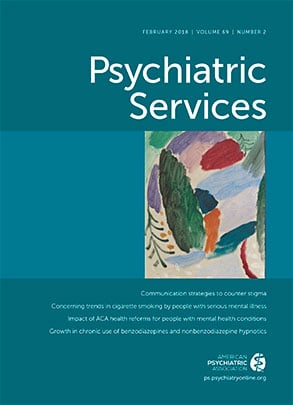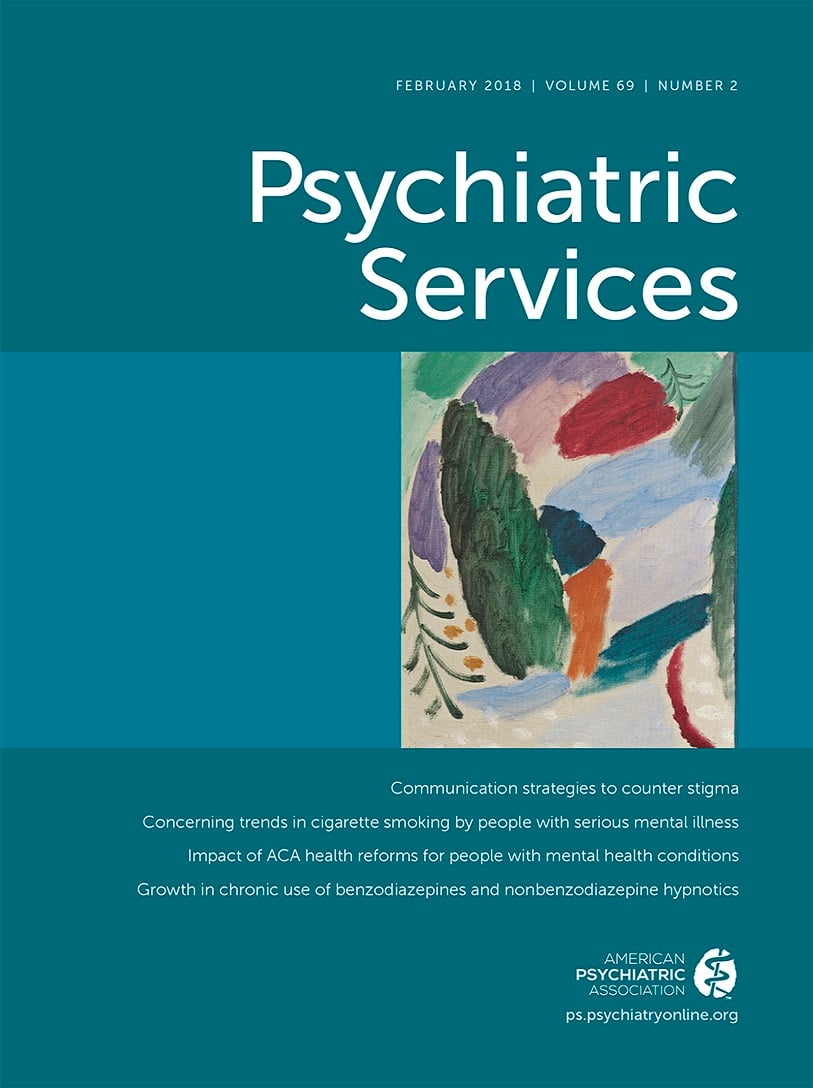Assertive community treatment (ACT) is perhaps the most studied and well-articulated service model for providing community-based, comprehensive mental health services to adults with serious mental illnesses, specifically schizophrenia, bipolar disorder, and major depression (
1). The ACT model consists of a multidisciplinary team that maintains a low consumer-to-staff ratio (ideally 10:1). ACT fidelity standards delineate specific service approaches, such as 24-hour coverage and direct involvement in hospital admissions and discharges, and they require that a majority (75%) of client contacts occur in the community rather than in an office-based setting. ACT has been shown to reduce rates of psychiatric hospitalization and improve residential stability for adults with serious mental illness who are living in the community (
2), with better outcomes associated with greater fidelity to the ACT model (
3).
ACT has the potential to serve as a medical home for adults with serious mental illness, who experience some of the most significant health disparities in the United States (
4). Prior research has shown that the structure and function of the ACT model overlaps with many of the patient-centered medical home standards (
5). A survey of ACT team leaders across the country found that nearly every respondent’s team routinely engaged in primary and preventive health care for this population (
6). Although primary care was not an original element of the ACT model, reports have suggested that formally integrating these services with ACT can lead to improvements in a variety of health care quality indicators (
7).
This study investigated the implementation of integrated primary and behavioral health care in five ACT programs during a three-year pilot period (2012–2014). These programs combined a Housing First approach to supported housing—providing immediate housing without readiness requirements or requirements for treatment participation—with integrated care through partnerships with federally qualified health centers (FQHCs). These programs were part of a larger initiative to integrate primary care into the public mental health system in Los Angeles County (
8).
Site Visits to Study Use of Integrated Care
We conducted site visits in order to develop a more detailed understanding of the implementation of integrated care in ACT. These site visits resembled an ACT fidelity site visit but focused specifically on aspects of integrated care. Site visits were guided by the Integrated Treatment Tool (ITT), a quality improvement tool for examining integration of primary and behavioral health care in organizational, clinical, and care coordination domains (
9). The site visits included in-depth semistructured interviews with program staff, observing program activities (such as client groups and staff meetings), reviewing program documents (policy and procedure manuals, clinical forms, and charts), and touring the program facility or shadowing a home visit. Field notes were taken throughout the visit to capture the content of the interviews and record observations and impressions.
Each site visit was followed by a report describing integration at the organizational and clinical levels as well as the site’s coordination of care. Each evaluator independently assessed for multiple items within each domain in the ITT, and reports were then reviewed as a group to compare findings and reach consensus. Completed site visit summaries were shared with program leaders for purposes of member checking. To facilitate within- and between-program comparisons, a case summary matrix was developed (
10) that involved reviewing points of convergence or divergence regarding integrated practices. Strategies of rigor for qualitative research used in this process included gathering and triangulating multiple forms of data, independent analysis, consensus-driven findings, and member checking (
11). Data on rates of screening for blood pressure, high-density lipoprotein, and blood glucose were derived from a Web-based health outcomes measurement system that was implemented as part of the program evaluation (
8).
Findings
Partnerships among the five ACT programs and their FQHCs each involved assigning a primary care provider (PCP)—either a medical doctor (N=3) or a nurse practitioner (N=2)—to the interdisciplinary ACT team. These PCPs participated in weekly ACT team meetings, which provided an opportunity for interdisciplinary communication and training and broader focus to enable more frequent attention to clients’ medical issues. Among the five programs emerged three distinct approaches to integrating primary care. Two programs colocated ACT team operations at the FQHC and maintained the practice of having primary care client encounters within the walls of the FQHC. In these cases, ACT team members provided support in the community to help clients schedule appointments and arrange transportation to the clinic for their medical care. In two other programs, PCPs split their time between the ACT program and the FQHC. Although clients could still be seen at the FQHC, PCPs in these two programs adopted a field-based approach, conducting home visits and providing clinical services in the community that included blood draws, blood pressure measurements, and wound care. The final program used a third model, in which a licensed nurse practitioner was hired by the FQHC and embedded full-time in the field-based ACT team.
These alternative approaches to integrating primary care in ACT had implications for care coordination. Colocation allowed the ACT team members in two programs to become familiar with FQHC processes, such as scheduling appointments, options for follow-up care, and referrals to specialty care. There were also differences between these two colocated programs. In one program, daily interaction between ACT and FQHC staff helped FQHC staff accommodate ACT clients whenever they visited the clinic, rather than only at scheduled visits. In the other program, the FQHC was both significantly larger and already served a population with high behavioral and general medical needs, which constrained FQHC staff’s willingness to provide additional accommodations for clients of the new integrated ACT team.
Among the two programs in which the PCPs split their time between the ACT team and the FQHC, medical examinations and screenings typically occurred at the FQHC, although the PCP conducted medical home visits as needed with the ACT teams. The PCP in one of these programs was more responsive to ongoing communication with other ACT team members. That is, even on days when assigned to the FQHC, the PCP remained in communication with ACT staff through the use of a group-text smartphone application that the ACT team used. This communication facilitated care coordination when ACT team members brought clients to the FQHC, because the PCP could alert FQHC staff members to any needed accommodations.
The program with a newly hired PCP embedded full-time in the ACT team decided at the outset of the project that the licensed nurse practitioner would focus primarily on health promotion. This decision was based in part because the PCP had limited knowledge of or influence on FQHC operations other than having access to the FQHC electronic medical records as an employee of the FQHC. This made complex care coordination challenging, in that scheduling appointments at the FQHC remained difficult.
Rates of screening for common chronic conditions varied significantly across programs (
Table 1). These differences were not accounted for by a specific approach to integrating primary care, because both colocation and splitting a PCP’s time between an ACT team and an FQHC resulted in both higher and lower rates of screening. Instead, higher rates of screening were observed in the two split-time programs where the PCPs helped to cultivate relationships between ACT and FQHC staff and facilitate access for ACT clients. The program with a PCP embedded on the ACT team but not integrated into the FQHC had the lowest screening rates, particularly for blood glucose levels to screen for diabetes, which requires a blood draw that is typically done within a clinical setting.
Discussion and Conclusions
ACT currently lacks a clearly established model for integrating primary care. It is unclear whether ACT requires the addition of a PCP for integrated care, given that the American Psychiatric Association recognizes a role for psychiatry in the delivery of primary care services in specialty mental health settings (
12). Our study suggests that there are multiple approaches to integrating primary care in the ACT model, each of which has strengths and challenges. All ACT teams in this project included other licensed medical staff members, such as a psychiatrist and either a registered nurse or vocational nurse specialist, who were field based and could provide some level of direct primary care. Yet when a PCP was added, rates of screening for chronic disease during the first year of enrollment were substantially higher than had been reported for populations with serious mental illness (increasing from 8% to 30%) (
4) and were similar to rates previously reported when integrating a PCP in ACT (
7).
Improved screening rates do not necessarily imply the delivery of patient-centered care or improvement in health outcomes. Client outcomes could not be assessed due to the variability in health screening rates and lack of data for many related health outcomes. Additional limitations of the study included a limited number of programs and a lack of comparison with ACT programs that did not include a PCP.
These integrated pilot programs were supported financially through combined behavioral health and primary care funding. The ACT model and the PCP were funded by the Los Angeles County Department of Mental Health through a flexible funding mechanism that allows the mental health funding stream to support limited primary care. Services provided by the FQHC were primarily funded by Medicaid, because most clients were Medicaid beneficiaries.
Partnering with FQHCs is one way that ACT programs can provide primary care, yet there is no single approach to integrating such care. Regardless, lifestyle interventions tailored for a population with serious mental illness are likely needed to improve health outcomes (
13), and there is a dearth of research on general health care interventions within ACT programs (
14). Additional research is needed to determine the extent to which ACT can simultaneously promote improved patient general medical and mental health outcomes.

